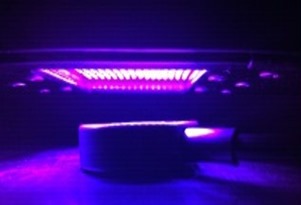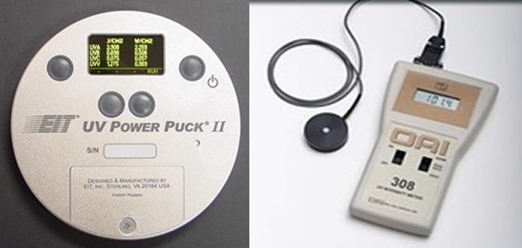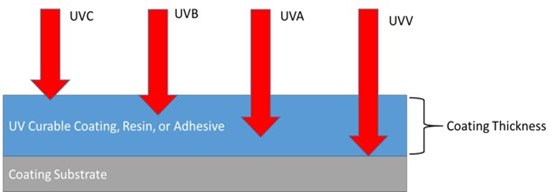Guest Post by Dan Lamone
 Image Courtesy: coatingsworld.com
Image Courtesy: coatingsworld.com
Last week the relationship between UV curable resins and power densities was introduced; this week we will discuss UV measurement and how you can use these UV measurements to evaluate a curing process.
While shopping for a UV measurement device, ask yourself the following questions:
- Do I need to measure multiple UV spectra (UVC, UVB, UVA) or just one?
- Is my process going to operate in a high power density or low power density regime?
- Is the measurement device for production/QC checks or developing a UV process?
UV measurement devices come in many different flavors and, as you might expect, you get what you pay for; however, those three questions will get you headed in the right direction. A UV meter measures incoming light rays by filtering UV radiation through an optical window of known surface area into a photo diode. You need to specify a wavelength range the measurement device because an optical filter will screen out all wavelengths outside the appropriate wavelength range. The photo diode detector will measure the intensity of UV radiation passing through the optical window to provide a power density measurement. Some devices provide power density versus time others provide average or peak power density. The exposure time of UV radiation at the optical window will be used to convert power density to the total energy density. Figure 1 below gives two example UV measurement devices.
Figure 1: UV Measurement Devices. Photo courtesy: EIT & OAI Instruments
The placement of the UV measurement device, specifically the UV detector, in your process is absolutely critical. The UV meter’s detector needs evaluate the same exposure conditions as the parts/coatings in your process with two variables of particular importance: distance and angle.
- UV power density decreases with the with the square of the distance from the UV source. If your coating is normally exposed 4” from the UV source and you measure 3” from the UV source, the measurement could be 50% higher than what your coating sees during exposure.
- Power density will also vary with the angle of exposure. Most processes place the UV source directly above the coating so that UV radiation is directed perpendicular to the surface. If the UV detector is not perpendicular (90°) to the UV source, the power density will vary with the cosine of that angle. If the detector surface is off by 45°, the UV measurement will be off by 30%.
Armed with a functioning UV measurement device and measurement system, formulators can relate UV exposure conditions to cured-coating properties and production engineers can optimize production throughput. I’d like to finish this post with two examples of relating UV measurement variables to processing considerations: heats of polymerization and depth of UV penetration.
For production processes that use acrylic UV-curable resins, the rate of polymerization has a secondary effect: heats of reaction. The polymerization of acrylic functionality liberates heat, 40-80 kJ/mol depending on the monomer. Most UV curable resins are coated to thin thicknesses covering relatively large surface areas which are capable of dissipating heats of reaction well. However, if the UV curable resin is coated to thickness greater than about 0.01-0.020” and the resin has a high degree of unsaturation (many acrylic groups to polymerize), the rate of heat generation may exceed the rate of heat dissipation at high reaction rates (i.e., high power density) causing the part/coating to heat up. Small temperature rises are generally benign in nature but large temperature rises can create coating performance flaws, create visual defects (bubbles or scorching), and/or cause thermal stresses at the substrate interface. This is one example of last week’s maxim that “lower intensities are better”.
Available coating thicknesses in your application depend strongly on the incoming UV source. Figure 2 below shows the relative depth of penetration for different UV sources at a constant power density.
Figure 2: Relative Depth of Penetration for UV sources at a Constant Power Density
UVC radiation is recommended for coating thickness less than 0.005” for high intensity systems and less than 0.002” for low power intensities. Since UVC radiation is strongly absorbed by organic materials, monomers at the UV resin’s surface will quickly polymerize and mask the un-cured monomers below. UVA radiation is suitable for most applications with depths of penetration extending into the 0.25” range. UVV radiation is employed for highly-filled systems that may scatter or absorb radiation. Relative depths of penetration can be extended further at higher power densities but, as mentioned before, higher power densities require additional considerations.
I’d like to thank InnoCentrix Senior Consultant Dan Lamone for his informative series on UV curing of thermosets. Do you have a UV curing challenge? Contact InnoCentrix and we can work with you to optimize your product and process.



True that “if you can’t measure it, you can’t manage it.” Direct measurement of the reaction of UV cured polymers is possible with dielectric cure monitoring. Fast instruments like the Lambient Technologies’ LTF-631 are routinely used to study UV cured materials.
Lambient Technologies (www.lambient.com) has an application note AN2.25 “Cure Monitoring of Near-UV Cured Gel Nail Polish,” which shows how different light sources affects the cure time of nail polish.
Link: https://www.lambient.com/docs/AN2.25CureMonitoringOfNear-UVCuredGelNailPolish.pdf
Hello. I have smd-led 392,5-395nm IV 1400-1600mW,.Is that suitable for curing ink? Can I use lower power for longer time or is highpower for short time better?